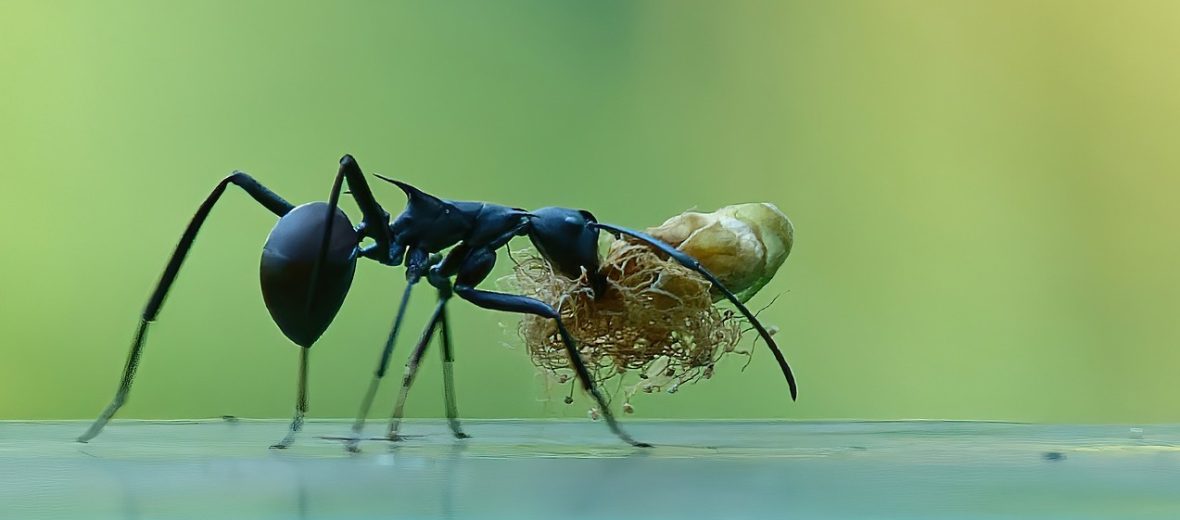
The carpenter ant can be found in decaying, moist, or hollow wood, mostly in forest environments. However, they can also infest your home. They build extensive underground tunnels and create galleries in the wood in homes that allows for easier traveling. Many times their tunnels lead to food sources, such as harvested aphid colonies; which are used for the aphid’s ability to create honeydew. They can be rather destructive to homes, but not as bad as termites. Most carpenter ants are not evaluated by the IUCN.
First the Stats…
Scientific name: Camponotus
Length: Up to .98 inch
Lifespan: Up to 12 weeks for workers | Up to 15 years for queens
Now on to the Facts!
1.) These ants are classified as both predators and scavengers.
2.) When foraging for food, they will extract the fluids of dead or dying insects and take the fluids back to their nest. Sometimes, they will also remove the insect’s head and take that back to their nest to extract the tissue from the head. Mmmm, brains.
3.) Like other ants, they use biochemical pheromones to mark the shortest path that can be taken from the nest to the food source. The other ants then follow this trail and collect said food.
4.) The workers will feed the queen and the larvae by eating the food they have located, and regurgitating (trophallaxis) the food in the nest.
5.) Despite popular opinion, carpenter ants don’t actually eat wood, as they are unable to digest cellulose.
But wait, there’s more on the carpenter ant!
6.) Some species of carpenter ant are able to obtain nitrogen by feeding on urine or urine-stained dirt or sand. This aids in increasing the nitrogen in the otherwise nitrogen-limited tunnels.
7.) Carpenter ants construct their nests to house eggs in environments with typically high levels of humidity due to their sensitivity to and need for a higher environmental humidity. However, there are some species of carpenter ants that prefer a drier environment.
Did you know…?
There are 9 known species of Asiatic carpenter ants that have the ability to explode. These ants have mandibular glands that run the entire length of their body. In an act known as autothysis, the threatened ant will suicidally rupture their glands and spray a toxic substance from their head onto the attacker.
8.) When the weather becomes warm and humid, the winged males and females engage in what is called nuptial flight. This is where they will leave their primary nest in order to find a mate and begin the reproduction process.
9.) Seeing as the ants regurgitate food for the larvae and queen, these critters also benefit from social immunity. This is where the regurgitate contains antimicrobial activity that is spread to the rest of the colony and strengthens their overall immunity to various pathogens.
10.) Carpenter ants are termed as oligogynous because they have several fertile queens in the nest that don’t tolerate each other and as a result need to spread to different areas of the nest.
But wait, there’s still more on the carpenter ant!
11.) Even though these ants are social, the queens tend to be defensive towards each other, if another queen presents herself in a previously marked territory.
Did you know…?
In Australia, the Honeypot ant is regularly eaten raw by Indigenous Australians. They will partially dig up their nest to expose the ants and only eat a few, to preserve the colony for future dining.
12.) The black carpenter ant is the most commonly seen of these ants around human habitations.
13.) These ants are considered a pest species due to the damage they cause to homes and other wooden structures.
14.) The Northern Paiute people of California ate the tickling, acid gasters of the big, jet-black carpenter ants.
15.) Predators of these ants are many and include, in part, birds, other insects, spiders, some mammals, and humans.
But wait, there’s still a little more on the carpenter ant!
16.) Queens mate with as many males as possible during her nuptial flight. Then she stores their sperm and produces thousands of eggs during her lifetime.
17.) Carpenter ants can lift more than 7 times their own weight.
Now a Short Carpenter Ant Video!
Now a Short Exploding Ant Video
Be sure to share & comment below! Also, check out the Critter Science YouTube channel. Videos added regularly!
Want to suggest a critter for me to write about? Let me know here.



